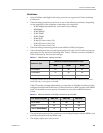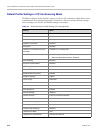
Polycom RealPresence Collaboration Server (RMX) 1500/2000/4000 Administrator’s Guide
2-8 Polycom, Inc.
• Video Clarity - Video Clarity feature applies video enhancing algorithms to incoming
video streams of resolutions up to and including SD.
• Supported resolutions:
— H.261 CIF/QCIF – Is supported in Continuous Presence (CP) conferences at
resolutions of 288 x 352 pixels (CIF) and 144 x 176 pixels (QCIF). Both resolutions
are supported at frame rates of up to 30 frames per second.
— H.263 4CIF - A high video resolution available to H.263 endpoints that do not
support H.264. It is only supported for conferences in which the video quality is set
to sharpness and for lines rates of 384kbps to 1920kbps.
— Standard Definition (SD) - A high quality video protocol which uses the H.264
and H.264 High Profile video algorithms. It enables compliant endpoints to
connect to Continuous Presence conferences at resolutions of 720X576 pixels for
PAL systems and 720X480 pixels for NTSC systems. For more information, see
"Video Resolutions in AVC-based CP Conferencing” on page 3-1.
— High Definition (HD) – HD is an ultra-high quality video resolution that uses he
H.264 and H.264 High Profile video algorithms. Depending on the RMX’s Card
Configuration mode compliant endpoints are able to connect to conferences at the
following resolutions:
• 720p (1280 x 720 pixels) in MPM, MPM+ and MPMx Card Configuration
Modes
• 1080p (1920 x 1080 pixels) in MPM+ and MPMx Card Configuration Modes
For more information, see "Video Resolutions in AVC-based CP Conferencing” on
page 3-1.
Supplemental Conferencing Features
In addition to Standard Conferencing the following features can be enabled:
• H.239 – Allows compliant endpoints to transmit and receive two simultaneous streams
of conference data to enable Content sharing. H.239 is also supported in cascading
conferences. Both H.263 and H.264 Content sharing protocols are supported. If all
endpoints connected to the conference have H.264 capability, Content is shared using
H.264, otherwise Content is shared using H.263.
For more information, see "H.239” on page 4-2.
• Lecture Mode – The lecturer is seen by all participants in full screen while the lecturer
views all conference participants in the selected video layout.
For more information, see "Lecture Mode (AVC Only)” on page 4-73.
• Presentation Mode (CP Conferences only) – When the current speaker’s speech
exceeds a predefined time (30 seconds), the conference layout automatically changes to
full screen, displaying the current speaker as the conference lecturer on all the
participants’ endpoints. During this time the speaker’s endpoint displays the previous
conference layout. When another participant starts talking, the Presentation Mode is
cancelled and the conference returns to its predefined video layout. Presentation mode
is available with Auto Layout and Same Layout.
— If the speaker in a video conference is an Audio Only participant, the Presentation
Mode is disabled for that participant.
From Version 7.1, MPM media cards are not supported.


















